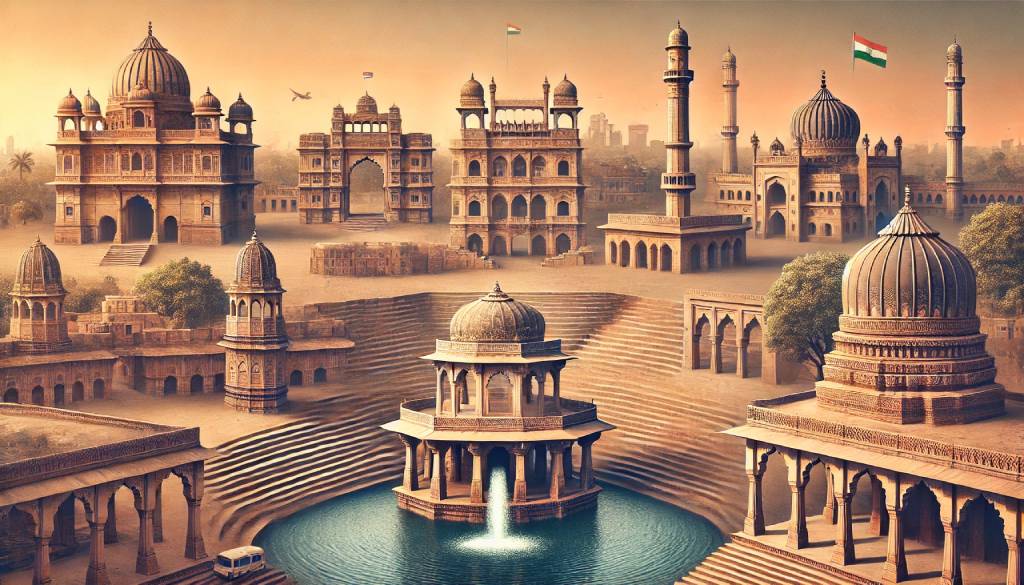10 Must-Visit Heritage Sites in Ahmedabad: A Journey Through History

Blog:
Introduction
Ahmedabad, the largest city in Gujarat, is a fascinating blend of historical grandeur and modern dynamism. A UNESCO World Heritage City, Ahmedabad is renowned for its impressive heritage sites that offer a glimpse into India’s rich cultural past. From ancient stepwells to intricately designed mosques, these historical gems reflect the city’s glorious architectural legacy. If you’re planning a trip, here’s a guide to the must-visit heritage sites in Ahmedabad that should be on your itinerary.
1. Sabarmati Ashram
Why Visit?
Located on the banks of the Sabarmati River, Sabarmati Ashram is one of the most significant heritage sites in India. It was home to Mahatma Gandhi from 1917 to 1930 and served as a hub for India’s freedom struggle. The peaceful environment makes it a perfect place for reflection.
What to See
Visit Gandhi’s living quarters, known as Hriday Kunj, explore the museum that houses his letters and photographs, and walk through the peaceful gardens that surround the Ashram.
2. Jama Masjid
Why Visit?
Built in 1424 by Sultan Ahmed Shah, the Jama Masjid is a striking example of Indo-Islamic architecture. Located in the heart of the old city, it remains one of the largest and most impressive mosques in India.
What to See
Admire the vast courtyard, intricately carved stone pillars, and beautiful domes. The fusion of Hindu, Jain, and Islamic styles in its architecture is a unique aspect that adds to the mosque’s appeal.
3. Adalaj Stepwell
Why Visit?
Adalaj Stepwell, located on the outskirts of Ahmedabad, is a stunning example of ancient water architecture. Built in 1499, it was designed to store water and serve as a cool retreat for travelers in the scorching heat of Gujarat.
What to See
Marvel at the detailed carvings on the walls, pillars, and ceilings. The structure, which goes down five stories, is a blend of Islamic and Hindu architecture, creating a mesmerizing visual experience.
4. Sidi Saiyyed Mosque
Why Visit?
Famous for its intricate stone latticework, especially the "Tree of Life" jali, the Sidi Saiyyed Mosque is an architectural gem of the city. Built in 1573, it’s one of the most photographed monuments in Ahmedabad.
What to See
The delicate latticework and geometric patterns of the mosque’s windows are masterpieces of craftsmanship. The elegance and intricacy of the carvings have made it an enduring symbol of the city.
5. Bhadra Fort
Why Visit?
Bhadra Fort, built in 1411 by Sultan Ahmed Shah, is an iconic monument that represents the city's medieval past. Originally a royal palace and fort, it now houses government offices but remains a significant historical landmark.
What to See
Explore the vast arches, majestic gates, and the Bhadra Kali Temple within the fort complex. The fort's grand architecture and its historical significance make it a must-visit for history enthusiasts.
6. Rani Ki Vav (Queen’s Stepwell)
Why Visit?
Recognized as a UNESCO World Heritage Site, Rani Ki Vav is located near Ahmedabad and is a stunning example of subterranean architecture. Built in the 11th century by Queen Udayamati, it stands as a tribute to her husband, King Bhima I.
What to See
Rani Ki Vav is known for its elaborate seven-story structure, filled with intricate carvings and over 800 sculptures. It’s a spectacular display of craftsmanship, making it a must-see for art and architecture lovers.
7. Heritage Walk of Ahmedabad
Why Visit?
The Heritage Walk of Ahmedabad is one of the best ways to immerse yourself in the old city’s culture and history. This guided tour takes you through narrow lanes, showcasing the unique pol houses, havelis, and temples that define Ahmedabad’s traditional charm.
What to See
The walk covers Swaminarayan Temple, old pol houses, and historical markets, providing a glimpse into the city’s architectural and cultural legacy. It’s a perfect way to experience the rich heritage in an intimate setting.
8. Calico Museum of Textiles
Why Visit?
Ahmedabad has long been a hub of India’s textile industry, and the Calico Museum of Textiles is a testament to that heritage. The museum houses an extraordinary collection of ancient and modern Indian textiles.
What to See
Explore the vast range of textiles, including rare examples of handwoven fabrics, intricate embroidery, and traditional block prints. The museum also offers insights into ancient textile-making techniques and India's textile history.
9. Teen Darwaza
Why Visit?
Teen Darwaza is one of the oldest gateways in Ahmedabad and a key symbol of the city’s architectural grandeur. Built in 1415, it served as the royal entrance to the Bhadra Fort.
What to See
Admire the majestic triple-arched gate, beautifully crafted with Islamic calligraphy and stonework. It’s a reminder of the city's royal past and architectural prowess.
10. Hutheesing Jain Temple
Why Visit?
Hutheesing Jain Temple is a magnificent temple complex built in 1848. Dedicated to the 15th Jain Tirthankar, Dharmanath, it’s a prime example of Jain temple architecture.
What to See
The temple is adorned with marble pillars, intricate carvings, and a central dome. The peaceful courtyard and the detailed craftsmanship of the temple make it a serene place to explore.
Conclusion
Ahmedabad is a treasure trove of heritage sites that offer a deep dive into India's rich history and culture. Whether you're exploring magnificent mosques, ancient stepwells, or historical forts, the city has something to offer every traveler. These must-visit heritage sites in Ahmedabad provide a window into the architectural splendor and cultural traditions that have shaped this historic city. Plan your visit and immerse yourself in the rich stories and beauty that Ahmedabad has to offer.
